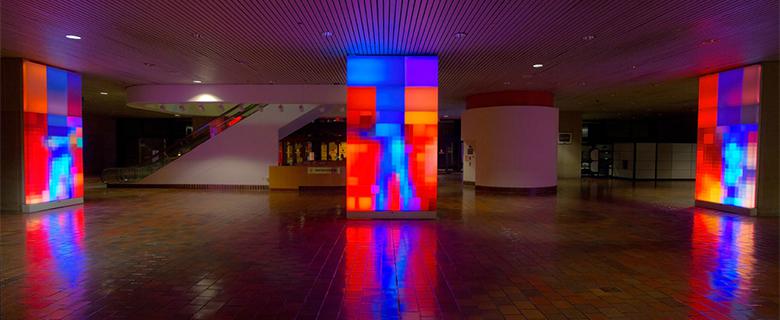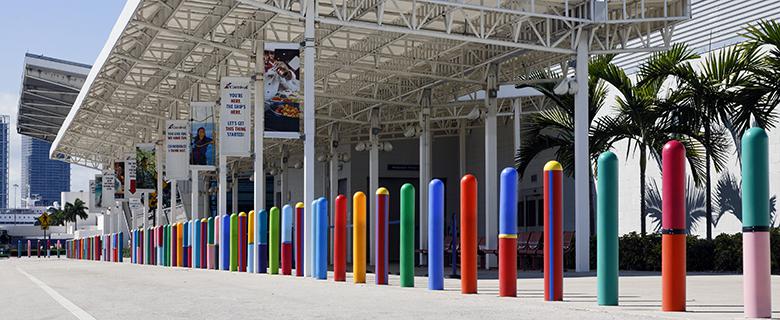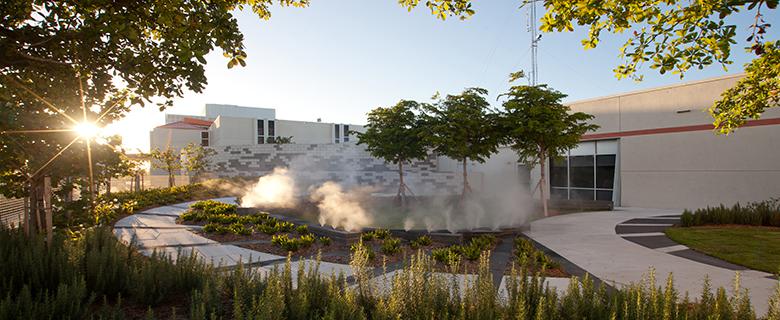Why the Playhouse failed
Q: Why did the Coconut Grove Playhouse fail and what led to its having to close its doors?
A: The Playhouse had a history of boom and bust cycles, starting with the original 1927 silent movie house that closed after only a few years of operation, even after adding sound for “talkies” in an effort to adapt to the times. The subsequent attempts to adapt the Playhouse for uses other than its original design as a movie theater led to its eventual failure.
A succession of owners eliminated the vast majority of the interior historic elements in efforts to convert the movie house into a working, live theater. What remains today is evidence of these unsuccessful attempts:
- the auditorium chamber was compressed by more than one-third to create a larger lobby area;
- interior features were eliminated to retrofit positions for stage lighting, sound and theater rigging; and
- added concrete raised the elevation and changed the rake of the auditorium floor, and an entire mezzanine was added, eliminating and/or entombing more historic interior features and creating poor and obstructed sight-lines.
These changes were accompanied by evolving audience preferences that no longer supported a larger theater. The growth of Miami’s cultural life has provided more options for cultural events and newer venues with 21st century accommodations to present performing arts productions. In its final decade, the limitations of the Playhouse, its diminishing audiences, and the expensive overhead of a physical plant that was too large and inefficient resulted in massive, accumulated deficits, forcing its most recent failure and closing of its doors.
Seating size
Q: What is the capacity of the existing auditorium vs. the proposed theater? Why reduce the seating size?
A: The seating capacity of the existing auditorium is 1150 seats. The proposed theater will have 300 seats, as specified in the Business Plan that is part of the lease with the State. It is significant to note that the existing movie theater seating was designed well before today’s more rigorous accessibility and egress codes and that the silent movie house was not designed to take into consideration necessary theatrical elements such as sight-lines and lighting positions. Adaptations to the movie house in the 1950’s attempted to improve the seating rake, but were not able to provide the standards necessary for a twenty-first century theater.
Factors contributing to the inability in this market to fill a larger house year-round at the Coconut Grove Playhouse include:
- More audience choices with the opening of other large venues such as the Adrienne Arsht Center for the Performing Arts, which was built specifically for large-scale productions and art forms: Broadway musicals (which themselves offer a total of only 8 performances per show in Miami-Dade County); ballet; opera; orchestral concerts; etc.;
- Today’s audiences’ expectations of higher quality experiences, including superb theatrical production values, a closer and more intimate relationship with the action on stage for dramatic theater, and up-to-date accommodations for comfort and accessibility; and
- The additional availability of other forms of entertainment, including on-demand programming through multiple media platforms.
The new 300-seat state-of-the-art theater will provide an intimate experience for audiences and performers that would not be possible in a larger house. For the presentation of dramatic theater, this sense of immediacy with the action on stage is key to creating a magical, live experience for audiences. With the new design, audience comfort and sight-lines are a priority, along with providing universal access to welcome and accommodate all audiences.
The impact of a bigger theater
Q: In real terms, what would a bigger theater do to Coconut Grove?
A: A bigger theater (e.g., in the 500-to-750 seat range) would trigger the following:
- More nightly traffic in Coconut Grove as a result of the increased volume of theater patrons coming at peak hours and leaving late at night;
- More density on the site to account for the footprint of the larger theater and its support spaces, eliminating the current plan’s pedestrian features, including:
- plazas;
- landscaping;
- the promenade connecting the residential neighborhood to Main Highway; and
- the park designed for the residential side of the parking garage;
- A larger, taller parking garage structure;
- Even greater detrimental impact on the residential neighborhood to the west due to:
- minimal, if any, buffers between the theater buildings and the street;
- the likelihood of more traffic up and down the residential streets; and
- perpetuating the walling off of this residential community from downtown Coconut Grove;
- A greater cost to operate, resulting in an unworkable business model, similar to those that caused the Playhouse’s repeated past failures; and
- A loss of the critical sense of intimacy between performers and audiences, known throughout the professional theater industry to be essential to today’s theater-goers who demand as immersive an experience as possible.
More seats = the certainty of more cost, without the certainty of more revenue
Q: Wouldn’t more seats generate more revenue?
A: More seats would generate more revenue only if they are sold seats. Yet, on a daily basis, a larger theater costs more to operate and sustain (higher utility fees, more staff required, more maintenance, etc.). If performances achieve less than the requisite attendance needed to cover the higher operating costs, deficits mount up. Given all the growing entertainment options available and from which to choose, it is increasing difficult to fill a large house with a live audience.
Leading experts on right-sizing the theater
Q: What do leading, national theater experts think about a 300-seat theater?
A: David Ives, Award-winning American playwright (including MacArthur; Guggenheim; Helen Hayes; Outer Critics Circle and Drama Desk Awards) recently wrote the following:
“A 700-seat theatre, it seems to me, won’t work. It would in fact be absurd. With 300 seats you have the necessary intimacy, the proportion that makes for good close-up humane theatre. And you can fill 300 seats if you’re resourceful and tasteful. A 700-seat theatre is begging for trouble. I don’t frankly know what kind of show you could put into a house of that size. It wouldn’t be a house, it would be more of a warehouse, and probably largely empty at that. Here in New York, theatres tend to run at 99 seats (off-off), or 299 seats (off-) or a thousand seats or more (Broadway). There used to be some 500-seat houses but they’ve pretty much gone. The reason is Darwinian: time and experience have shown theatre owners and artistic directors that those are the comfortable sizes for theatres.”
A: Marco Ramirez, Miamian, Award-winning playwright/film & TV screenwriter/producer (including Obie, Outer Critics Circle and Drama Desk Awards; credits include “Orange is the New Black,” “Sons of Anarchy,” “The Defenders”) writes:
“My love for the theatre was born at Gablestage …it was the intimate, emotionally stirring performance I saw at GableStage (their 1999 adaptation of Steinbeck’s Of Mice and Men) that spawned my love for theatre. Not for big, traveling Broadway shows. Not for massive sets and parades of costumes. But for a smaller, smarter kind of theatre. The kind where a cast of six actors (or less) delves into ethical issues, historical events (GableStage’s 2002 production of The Diary of Anne Frank), race relations (their 2004 Master Harold and the Boys), or the nature of human sexuality (their 2003 production of Edward Albee’s The Goat).”
A: Deborah Zoe Laufer, Award-winning playwright (including Helen Merrill and Lilly Awards) provides these observations:
“This past August, I had the enormous pleasure of directing my play, Informed Consent, at GableStage.… I’ve had over 100 productions of my plays around the country (and overseas), but I was blown away by the quality of the work done there – the level of design realized in that somewhat difficult space, and the challenging work Joe chooses to produce…. The idea that a 700 seat space would be preferable to a 300 seat space is the kind of thinking that someone who isn’t involved with theater would have. A 700 seat space would require the mounting of big musicals or plays that have a “name” and don’t require any real intimacy. A 300 seat space will allow GableStage to grow, while still doing the cutting edge work it’s known for.”
This link provides the entire letters excerpted above.
Other 300-seat theaters in Miami-Dade County
Q: Are there other theaters in Miami-Dade County in the 300-seat range?
A: While a few theaters exist in Miami-Dade County within the 300-400 seat range, such as Miami Theater Center in Miami Shores (330 seats) and the Miracle Theater in Coral Gables (100, 300, and 600 seats), these venues are programmed by resident producing organizations that manage them. The new 300-seat theater proposed for the Coconut Grove Playhouse will be purposefully designed and built for twenty-first century theater, creating a complex specifically developed to serve as one of the nation’s great regional theaters and presenting the best of contemporary and classical dramatic theater.
Is a larger theater contemplated?
Q: Is there a larger, 700-seat theater scheme contemplated?
A: The plan approved by the Board of County Commissioners, FIU and the State of Florida is for a complex that features a 300-seat theater. Miami-Dade County, through its executed contracts and agreements, is advancing and implementing this plan.
A larger, costlier 700-seat theater has been discussed but is not being considered as it is not a financially, programmatically nor urbanistically viable option.






